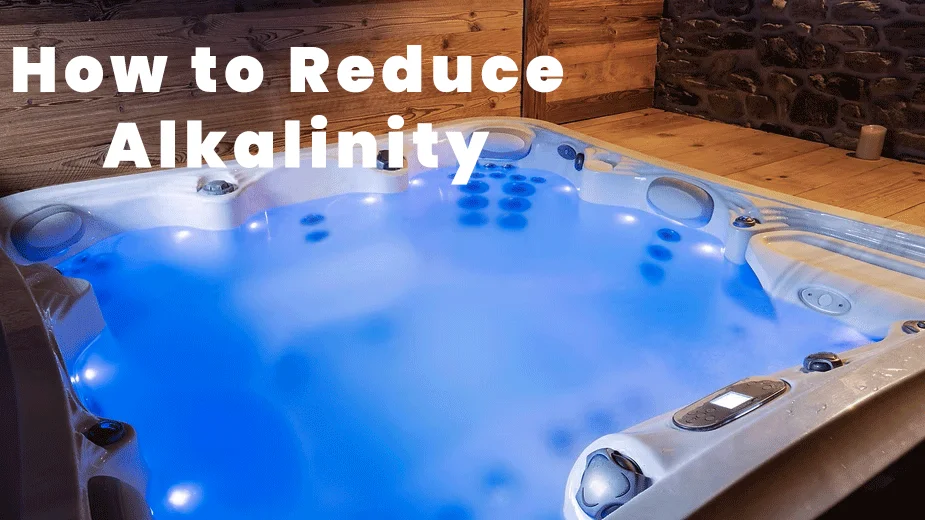Maintaining a hot tub depends on optimal water chemistry balance, which also determines the lifetime of your equipment and soak comfort. Among the several elements of hot tub maintenance, alkalinity is one of the most crucial ones to check. Still, why does it matter and what precisely is alkalinity? Everything you need to know about alkalinity, its effects on your hot tub, and—above all—how to reduce alkalinity in a hot tub to maintain clean, safe water for usage will be covered in this tutorial.
Understanding Hot Tub Alkalinity
What is Alkalinity?
In hot tubs, alkalinity describes how well the water neutralizes acids. It serves as a buffer, therefore stopping sharp pH level variations. Alkalinity helps preserve the pH level within a healthy range whereas pH gauges the water’s acidity or basic nature. Between 80 and 120 ppm (parts per million), is the perfect total alkalinity (TA) level for hot tub water. When alkalinity falls within this range, it guarantees that the pH of your hot tub remains constant, so preventing quick changes that can harm your spa equipment or aggravate your skin.
Why is Alkalinity a Factor?
Your hot tub’s whole water chemistry depends critically on alkalinity. It keeps water clarity, stops scale development, and increases the potency of sanitizers such as bromine or chlorine. pH levels can swing wildly without appropriate alkalinity, causing problems including calcium scaling, cloudiness of water, or lower sanitizer efficiency.
Signs of High Alkalinity in Your Hot Tub
When Alkalinity is Too High?
Many issues in your hot tub could result from high alkalinity levels. Cloudy water is one of the most obvious indicators; this results from high alkalinity causing a mineral accumulation including calcium. Unchecked, this can cause calcium scaling—where chalky white deposits develop on surfaces, jets, and equipment of your spa. This not only lessens the attractiveness of your hot tub but may also shorten the lifetime of your equipment and compromise interior components.
Apart from hazy water, high alkalinity might lower the efficacy of sanitizers, therefore compromising their maintenance of safe and clean water. This might cause problems like green water or more bacterial development, rendering the spa dangerous for use.
How Can High Alkalinity Affect Eyes and Skin?
Furthermore causing skin irritation and eye pain are the high pH values sometimes linked with high alkalinity. Your alkalinity is most definitely out of balance if you get itching, dryness, or a burning feeling in your eyes while using your hot tub.
Testing Alkalinity Levels
How to Check Alkalinity in Your Hot Tub
One easy but important component of normal maintenance for your hot tub is checking its alkalinity. Either test strips or a more exact digital tester will let you check alkalinity. Here is a detailed guide on testing alkalinity:
Obtain a water sample: To sample your hot tub water, use a fresh container.
Dip the test strip: Following directions on the package, dip the test strip into the water sample. To find the alkalinity level, after a few seconds match the color of the strip to the given chart.
Record the results: Your alkalinity should fall between 80 and 120 ppm. Should it be outside this range, you will have to modify.
Maintaining appropriate alkalinity levels and avoiding any possible problems depend on regular testing, minimum twice a week.
Methodical Process for Reducing Alkalinity in a Hot Tub
Should your test findings reveal that the alkalinity of your hot tub is very high, there are many ways to restore balance:
Using a pH Reducer: One of the most often used methods to reduce alkalinity is with a pH reducer, such sodium bisulfate. This chemical lowers the alkalinity and pH of your water.
Apply pH reducer: Following manufacturer recommendations for applying pH reducers is always wise. One cupful usually reduces the alkalinity of one thousand gallons of water by roughly 10 ppm. Add the chemical gradually; check the water 24 hours to be sure you do not overcorrect.
Using White Vinegar: White vinegar will help to lower alkalinity in a more natural manner. Just toss a tiny bit into your hot tub water, swirl, and retest over some time.
Important Tip:
After any change, always check the water to be sure the required alkalinity level is obtained. Too much chemical all at once should be avoided since it can cause more notable pH abnormalities.
Stopping Future High Alkalinity in Hot Tub Maintenance Advice
Once your alkalinity has dropped to the proper level, you must follow a regimen to keep it that way. These suggestions will help to avoid high alkalinity from reoccurring:
Regular Water Testing: As was already said, at least twice a week hot tub water testing can help you identify any imbalances early on.
Avoid Overuse of Chemicals: Steer clear of chemical overuse by utilizing items like soda ash or baking soda, which raises alkalinity levels. Always carefully measure chemicals; try not to add pointless extras.
Invest in Quality Spa Shock & Sanitizer: Invest in premium spa shock and sanitizer to help preserve the chemistry of your water and avoid imbalances.
Ensure Proper Filtration: Verify the operational efficiency of the filtration system in your hot tub. Bad filtering can cause water clarity problems and chemical imbalance.
Following a testing and water-adjusting schedule can help you prevent future alkalinity issues and maintain the best possible state of your hot tub.
Debugging Typical Problems
How to Respond When Issues Develop
Your hot tub’s water quality could still be problematic even with frequent testing and maintenance. These are some typical issues and fixes:
Green Water: Should your water turn green, this could indicate that your alkalinity is excessively high and the sanitizer is malfunctioning. To clear things, cut the alkalinity and raise sanitizer levels.
Cloudy Water: Another indication of great alkalinity and potential for calcium scaling is cloudiness of water. Cut the alkalinity and give your hot tub a thorough cleaning.
Calcium Deposits: Remove calcium deposits from jets and other surfaces using whirlpool or spa cleaning. Maintaining your alkalinity in the recommended range will help to prevent scaling.
Aeration: Keeping the jets running or an air pump aerating your hot tub water will also help to balance pH and alkalinity.
In Conclusion
Maintaining water clarity, safeguarding your equipment, and guaranteeing a nice and safe dip depend on keeping appropriate alkalinity in your hot tub. Your hot tub will be year-round sparkling clean if you routinely test your water, change alkalinity levels as necessary, and apply preventative action. See a specialist to help you decide on the proper balance or how to manage particular problems so that your hot tub remains in the best shape.
Remember, a well-kept hot tub creates a delightful experience every time you plunge rather than only maintaining the water clean. So keep testing, changing, and unwinding.







